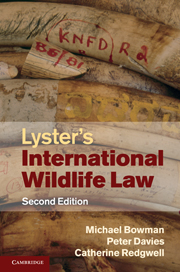Book contents
- Frontmatter
- Contents
- Foreword
- Preface
- List of abbreviations
- PART I Foundations of international wildlife law
- PART II Species regulation
- PART III Regional wildlife regulation
- PART IV Global wildlife regulation
- 13 The Ramsar Convention on Wetlands
- 14 The World Heritage Convention
- 15 The Convention on International Trade in Endangered Species of Wild Fauna and Flora
- 16 The Convention on the Conservation of Migratory Species
- PART V Biological diversity: a new perspective on wildlife regulation
- PART VI Cross-sectoral issues in wildlife regulation
- PART VII Conclusion
- Index
- References
15 - The Convention on International Trade in Endangered Species of Wild Fauna and Flora
Published online by Cambridge University Press: 05 July 2011
- Frontmatter
- Contents
- Foreword
- Preface
- List of abbreviations
- PART I Foundations of international wildlife law
- PART II Species regulation
- PART III Regional wildlife regulation
- PART IV Global wildlife regulation
- 13 The Ramsar Convention on Wetlands
- 14 The World Heritage Convention
- 15 The Convention on International Trade in Endangered Species of Wild Fauna and Flora
- 16 The Convention on the Conservation of Migratory Species
- PART V Biological diversity: a new perspective on wildlife regulation
- PART VI Cross-sectoral issues in wildlife regulation
- PART VII Conclusion
- Index
- References
Summary
Background
International trade in wildlife is big business, ‘estimated to be worth billions of dollars and to include hundreds of millions of plant and animal specimens’. The trade goes back for centuries, but there was a dramatic increase in its volume during the 1960s and 1970s. For example, by the late 1960s a staggering 5–10 million crocodilian skins were entering international trade each year. International wildlife trade continues apace today – during 2002 and 2003 the USA alone issued 1,547 permits for imported sport-hunted leopard trophies and 250 permits for sport-hunted elephant trophies. In addition, European Union member states imported ‘six million live birds, 1.6 million live reptiles, around 10 million reptile skins, 21 million orchids and 579 t of sturgeon caviar’ between 1996 and 2002, and the legal trade in 2005 ‘in wildlife products in the EU had an estimated declared import value of EUR93 billion’. Often involvement in wildlife trade can make the difference between a comfortable lifestyle and a basic one; for example, those involved in the collection of marine specimens in Fiji can expect to receive a monthly income of US$425 when compared to the average wage of US$50 per month.
The first demand for controls on the international wildlife trade was made as early as 1911 when Paul Sarasin, a Swiss conservationist, called for restrictions on the import and export of bird feathers because of the effect of the vogue for plumed hats on bird populations.
- Type
- Chapter
- Information
- Lyster's International Wildlife Law , pp. 483 - 534Publisher: Cambridge University PressPrint publication year: 2010
References
- 1
- Cited by



